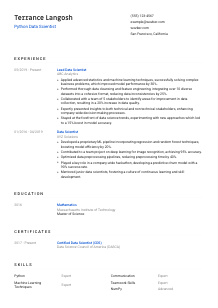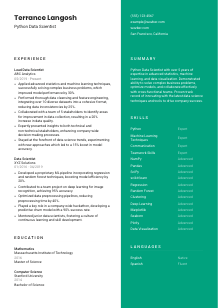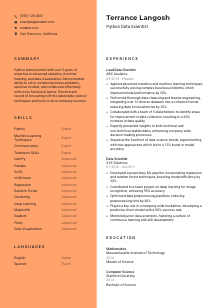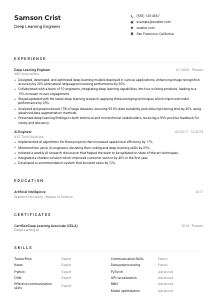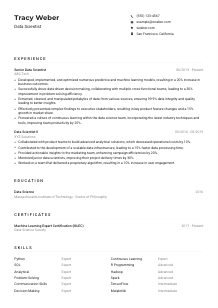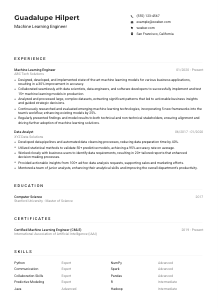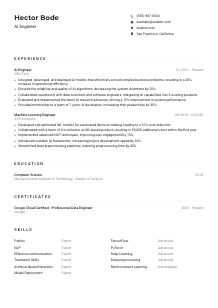Python Data Scientist Resume Example
Crafting code and weaving insights, but your resume feels hidden in a data sieve? Delve into this Python Data Scientist resume example, calibrated with Wozber free resume builder. Uncover how to blend your Python prowess and data dexterity with job calls, making sure your career skyline sparkles as clean and structured as your algorithmic scripts!

How to write a Python Data Scientist Resume?
Hello, aspiring Python Data Scientist! In a world where data is king, carving out your niche in this domain isn't just desirable—it's essential. Your resume isn't just a document; it's a powerful storytelling tool that narrates your journey, expertise, and the unique value you bring to the table. As we navigate through the art and science of tailoring a resume with Wozber, a free resume builder designed for optimal ATS compliance, you'll discover how to turn your Python Data Scientist aspirations into an irresistible professional narrative.
Ready to elevate your career trajectory? Let's dive in and transform your resume into a beacon for your dream job!
Personal Details
First impressions matter, especially in the competitive field of Data Science. Starting with your Personal Details, let's ensure your introduction is not only impeccable but also strategically aligned with your desired Python Data Scientist position.
1. Brand Yourself Right
Think of your name as your brand's logo. Make sure it's the first thing that catches the hiring manager's eye with minimalistic yet impactful typography on your ATS-friendly resume template.
2. Match Your Title
Directly under your name, mirror the job title you're aiming for, in this case, 'Python Data Scientist'. This tactic instantly aligns your personal brand with the job expectations, signaling to the ATS that you're a relevant match.
3. Key Contact Information
Always include your phone number and a professional email. Consider an email format like firstname.lastname@email.com for a polished look. This essential information assists recruiters in easily reaching out to you.
4. Location Matters
Given that the specified job requires you to be in or relocate to San Francisco, California, highlighting your current city and state here if you're already in San Francisco can be a subtle yet effective nudge confirming your eligibility.
5. Online Professional Presence
Including a link to a well-curated LinkedIn profile or a personal portfolio website can offer deeper insights into your professional endeavors. Ensure your online professional presence accurately reflects your resume.
Takeaway
Your Personal Details section is the handshake that sets the tone for your professional narrative. By ensuring these details are neatly presented and aligned with the job's geographical and professional criteria, you're setting the stage for a strong first impression. Let this section act as your business card, inviting the hiring manager to delve deeper into your potential as a Python Data Scientist.





Experience
In the realm of Python Data Science, your experience speaks volumes. This section is your opportunity to demonstrate your standing as an exceptional candidate through your practical contributions and technical prowess.
- Applied advanced statistics and machine learning techniques, successfully solving complex business problems, which improved model performance by 30%.
- Performed thorough data cleansing and feature engineering, integrating over 10 diverse datasets into a cohesive format, reducing data inconsistencies by 25%.
- Collaborated with a team of 5 stakeholders to identify areas for improvement in data collection, resulting in a 20% increase in data quality.
- Expertly presented insights to both technical and non‑technical stakeholders, enhancing company‑wide decision‑making processes.
- Stayed at the forefront of data science trends, experimenting with new approaches which led to a 15% boost in model accuracy.
- Developed a proprietary ML pipeline incorporating regression and random forest techniques, boosting model efficiency by 20%.
- Contributed to a team project on deep learning for image recognition, achieving 95% accuracy.
- Optimized data preprocessing pipelines, reducing preprocessing time by 40%.
- Played a key role in a company‑wide hackathon, developing a predictive churn model with a 90% success rate.
- Mentored junior data scientists, fostering a culture of continuous learning and skill development.
1. Detail Your Roles
Start by detailing your previous positions, focusing on roles where you've wielded Python and relevant data science libraries like NumPy and Pandas. This will show your direct experience and attract the attention of both the ATS and the hiring manager.
2. Quantify Your Impact
Numbers talk. For instance, stating 'improved model performance by 30%' quantifies your contribution and provides concrete evidence of your capabilities. This precision showcases the tangible value you've brought to your previous roles.
3. Tailor to the Job Description
Mirror the language and keywords of the job description in your accomplishments. If the job requires 'applying advanced statistics and machine learning techniques,' highlight specific instances where you've done just that.
4. Collaborative Success
Emphasize teamwork and collaboration, key skills highlighted in the job description. An example might be, 'collaborated with cross-functional teams to integrate multiple data sources,' showcasing your ability to work in harmony with others for superior outcomes.
5. Stay Relevant and Recent
Prioritize recent roles and projects that best reflect the requirements of the Python Data Scientist position. This keeps your resume current and laser-focused on what the hiring managers are seeking.
Takeaway
Craft each bullet point in your Experience section to reflect your meaningful contributions and how they align with the specific skills and accomplishments sought by your potential employer. By demonstrating your expertise and successes with precision and relevance, you're not just telling them you're right for the job; you're showing them. This is how you distinguish yourself as the optimal candidate for the Python Data Scientist role.
Education
While technical skills and experience shine on a Python Data Scientist resume, the foundation of your education is what sets you up for success. Here's how to frame your academic background to resonate with the expectations of your dream role.
1. Match Degrees to Requirements
Highlight your 'Bachelor's or advanced degree in Computer Science, Mathematics, Statistics, or related quantitative field,' as specified in the job description. This directly aligns your educational qualifications with the job's prerequisites.
2. Use a Clear Structure
Organize your education section starting with the highest degree first. Include the degree type, field of study, the institution's name, and graduation year. This structure offers easy readability and allows hiring managers to quickly confirm your academic credentials.
3. Emphasize Relevant Achievements
If you've undertaken specific courses, projects, or publications relevant to data science or Python programming, mention them. This could further establish your dedication and knowledge in the field.
4. Continuous Learning
For a field as dynamic as Python Data Science, showing that you're engaged in continuous learning through workshops or additional certifications related to the latest industry trends can be highly appealing to potential employers.
5. Honors and Extracurriculars
While not always necessary, including honors or extracurricular activities that showcase leadership or involvement in tech communities can add a more personal touch and give insight into your character and interests.
Takeaway
The Education section of your resume is more than a list of degrees—it's a narrative of your academic journey and how it has prepared you for the challenges of the Python Data Scientist role. By strategically aligning this section with the job requirements, you ensure that your foundational knowledge and engagement in the field are clearly showcased.
Certificates
In the fast-evolving field of Python Data Science, certifications can give you an extra edge, demonstrating your commitment to learning and excellence. Let's curate this section to highlight the most relevant certifications.
1. Select Strategically
Choose certificates that are directly relevant to the job's requirements. For example, 'Certified Data Scientist (CDS)' directly signals your validated expertise in data science, making it highly relevant for the Python Data Scientist position.
2. Prioritize Recent and Relevant
Focus on listing certifications that are recent or have ongoing significance in the field of Python Data Science. This shows your drive for continuous improvement and keeps your resume current.
3. Details Matter
For each certification, include the name of the certifying body and the date of certification. This provides clear verification of your qualifications and keeps your resume ATS-friendly.
4. Lifelong Learning
Highlighting certificates demonstrates not just your skills, but also your commitment to continuous learning—a critical trait in a field as dynamic as Python Data Science. Keep seeking out and adding new certifications to your resume.
Takeaway
Think of your certifications as badges of honor, showcasing your dedication and prowess. By carefully selecting and presenting certifications that match the job specifications, you're offering hiring managers hard proof of your qualifications and your eagerness to stay at the forefront of Python Data Science advancements.
Skills
The Skills section of your resume is like a quick-reference guide to your professional toolkit. This is where you get to showcase the technical prowess and soft skills that make you an ideal candidate for the Python Data Scientist role.
1. Identify from Job Description
Carefully analyze the job description and list skills that directly match the requirements, such as proficiency in 'Python and relevant data science libraries (NumPy, Pandas, SciPy, scikit-learn, etc.).' This ensures your resume speaks directly to what the hiring manager is looking for.
2. Blend Hard and Soft Skills
While the technical skills are crucial, don't forget to also include soft skills like 'excellent communication and teamwork skills' as mentioned in the job description. This balanced skill set paints the picture of a well-rounded candidate.
3. Organize and Prioritize
Start with your strongest, most relevant skills and organize them in a clean, easy-to-read format. Using an ATS-friendly resume format ensures that your skills are clearly presented and easily identifiable by both the ATS and the hiring manager.
Takeaway
Your Skills section is a powerful component of your resume, offering a concise snapshot of the expertise you bring to the Python Data Scientist role. By carefully selecting and organizing your skills, you communicate your fit for the role and your readiness to contribute meaningfully to your prospective team.
Languages
In our interconnected world, the ability to communicate in multiple languages can significantly amplify your appeal as a Python Data Scientist. This section highlights how to weave your linguistic capabilities into a resume tailored for a global stage.
1. Match Job Specifications
If the job listing emphasizes 'effective use of the English language is essential,' ensure that your proficiency in English is clearly listed and categorized as 'Native' or 'Fluent,' as appropriate.
2. Showcase Multilingual Skills
Besides the essential language(s) required by the job, listing additional languages can demonstrate your ability to work in diverse teams and environments, a valuable asset in the ever-globalizing field of Data Science.
3. Be Honest About Your Level
Use clear terms to categorize your proficiency levels (Native, Fluent, Intermediate, Basic). This honesty ensures that expectations are accurately set, fostering trust right from the start.
4. Consider the Workplace
If the role involves international collaboration or clientele, your multilingual abilities become even more pertinent. Understand the broader scope of the role and tailor this section to reflect the languages that could offer the most value in such contexts.
5. Continuous Improvement
View languages as a skill set that can always be expanded. Whether it's deepening your proficiency in a currently spoken language or learning a new one, this pursuit not only enhances your personal growth but also your professional versatility.
Takeaway
Your proficiency in multiple languages is a testament to your ability to navigate and thrive in diverse settings, an invaluable trait in the world of Python Data Science. Showcase your linguistic skills as the tools that enable you to connect data, people, and stories across cultures and geographies.
Summary
The Summary section serves as your resume's opening narrative, offering a brief yet impactful glimpse into your professional identity. A well-crafted summary can set the tone for the entire document, captivating the hiring manager's attention from the get-go.
1. Incorporate Job Requirements
Digest the job description and interweave key requirements into your summary. For instance, a sentence like 'Python Data Scientist with over 5 years of expertise in advanced statistics, machine learning, and data visualization' ticks off multiple boxes right away.
2. Highlight Your Unique Contributions
What have you achieved in your career that makes you stand out? Whether it's an innovative project, a complex problem you solved, or a model you optimized, highlight these to show your potential value to the team.
3. Catch Their Eye
Keep your summary concise but powerful. Aim for 3-5 lines that encapsulate your professional essence, drawing the reader into the narrative of you. Think of it as your professional headline—make it catchy!
4. Keep It Relevant
Tailor your summary to reflect not just your general experience, but specifically why you're a great fit for this Python Data Scientist role. Ensure every sentence speaks volumes about your suitability for the position.
Takeaway
Think of your Summary section as the highlight reel of your professional journey. It's your chance to showcase your expertise and uniqueness in a nutshell. By aligning it closely with the job requirements, you ensure that your resume starts off on the right note, clearly communicating that you are an exemplary candidate for the Python Data Scientist role. Remember, a well-crafted summary is the hook that can intrigue and engage the hiring manager to explore the rest of your resume.
Launching Your Python Data Scientist Journey
Congratulations on taking this comprehensive dive into crafting a tailored Python Data Scientist resume! With these insights and strategies, you're well-equipped to create a resume using Wozber's free resume builder that not only ticks all the boxes for ATS compliance but also captures the essence of your professional prowess. Remember, your resume is the gateway to your next great opportunity. Refine it, infuse it with your personal brand, and let it serve as a testament to your skills and ambitions.
The world of Python Data Science awaits your brilliance. Start building your resume today and step confidently toward your next challenge!

- Bachelor's or advanced degree in Computer Science, Mathematics, Statistics, or related quantitative field.
- Minimum of 3 years experience as a Data Scientist with proficiency in Python and relevant data science libraries (NumPy, Pandas, SciPy, scikit-learn, etc.).
- Strong expertise in machine learning techniques such as regression, random forest, clustering, and deep learning.
- Proficiency in data visualization tools such as Matplotlib, Seaborn, and Plotly.
- Excellent communication and teamwork skills to collaborate effectively with cross-functional teams.
- Effective use of the English language is essential.
- Must be located in or willing to relocate to San Francisco, CA.
- Apply advanced statistics and machine learning techniques to solve complex business problems, optimize models, and improve performance.
- Perform data cleansing, feature engineering, and integrate multiple data sources into usable formats.
- Collaborate with stakeholders to understand analytics objectives and identify areas for improvement in data collection or machine learning model implementation.
- Present insights and findings to both technical and non-technical stakeholders in a clear, concise manner.
- Stay up-to-date with the latest trends and techniques in data science and experiment with new approaches to solving problems.





